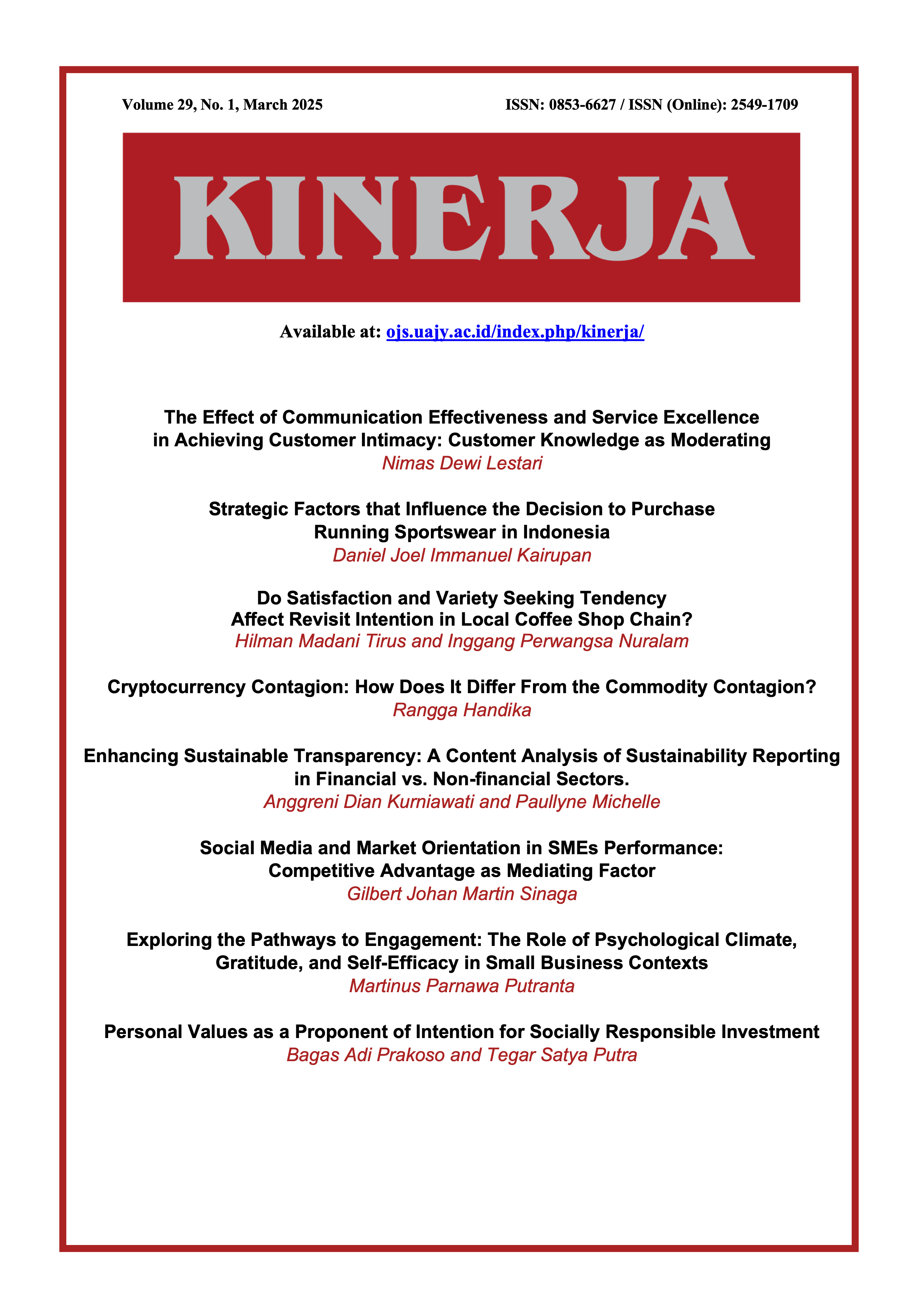Enhancing Sustainable Transparency: A Content Analysis of Sustainability Reporting in Financial vs. Non-financial Sectors
DOI:
https://doi.org/10.24002/kinerja.v29i1.10338Keywords:
content analysis, financial industry, non-financial industry, sustainability reportingAbstract
Sustainability reporting is becoming increasingly important for companies across various industries due to the growing awareness of sustainability issues and the stakeholders demand for sustainability performance information. However, sustainability reporting practices might differ throughout industries due to their specific characteristics. This study aims to compare sustainable reporting practices in financial and non-financial industries. A descriptive qualitative approach using secondary data is chosen in which the 2022 sustainability report was produced by the top ten financial and non-financial companies listed on the Indonesia Stock Exchange. This study uses content analysis with Landrum model categories and keyword frequency to evaluate the transparency levels of financial and non-financial industries’ sustainability reporting. The findings reveal that financial industries disclose more about the environment or ecology than non-financial industries that are more business- centered. The results of this study contribute to companies improving sustainable reporting practices and helping stakeholders understand sustainability information reported by companies in different industries so that they can make better decisions.
References
Aggarwal, P. and Singh, A.K., 2019. CSR and sustainability reporting practices in India: An in-depth content analysis of top-listed companies. Social Responsibility Journal, 15(8), pp.1033–1053. Available at: https://doi.org/10.1108/SRJ-03-2018-0078
Agustia, D., Sawarjuwono, T. and Dianawati, W., 2018. Green innovation as implementation of sustainability development in Indonesia. ICIEBP 2017, pp.364–369. Available at: https://doi.org/10.5220/0007082303640369
Amos, G.J., 2023. Sustainability reporting in multinational enterprises: Focus on human resources and community. Research Journal of Finance and Accounting, 14(19), pp.45–54.
Biswas, N., 2011. Sustainable green banking approach: The need of the hour. Business Spectrum, 1(1), pp.32–38.
Brammer, S. and Pavelin, S., 2004. Building a good reputation. European Management Journal, 22(6), pp.704–713. Available at: https://doi.org/10.1016/j.emj.2004.09.033
Buallay, A., 2019. Is sustainability reporting (ESG) associated with performance? Evidence from the European banking sector. Management of Environmental Quality: An International Journal, 30(1), pp.98–115. Available at: https://doi.org/10.1108/MEQ-12-2017-0149
Cakranegara, P.A. and Sidjabat, F.M., 2021. Green investment: Incorporate environment, social, and government factors in investment decision. Eksis: Jurnal Riset Ekonomi dan Bisnis, 16(1), pp.17–28. Available at: https://doi.org/10.26533/eksis.v16i1.773
Freeman, R.E. and David, L.R., 1983. Stockholders and stakeholders: A new perspective on corporate governance. California Management Review, 25(3), pp.88–106. Available at: https://doi.org/10.2307/41165018
Galeotti, R.M., Camilleri, M.A., Roberto, F. and Sepe, F., 2023. Stakeholder engagement disclosures in sustainability reports: Evidence from Italian food companies. Business Ethics, the Environment & Responsibility, 34(1), pp.260-279. Available at: https://doi.org/10.1111/beer.12642
Indonesia Environment & Energy Center, 2024. The role of society in environmental impact analysis, regulation enforcement, and sustainability. Indonesia Environment & Energy Center News. Available at: https://environment-indonesia.com/peran-masyarakat-dalam-amdal-penerapan-regulasi-dan-keberlanjutan-lingkungan/
Islam, F., Shahbaz, M., Ahmed, A.U. and Alam, M.M., 2013. Financial development and energy consumption nexus in Malaysia: a multivariate time series analysis. Economic Modelling, 30(1), pp.435–441. Available at: https://doi.org/10.1016/j.econmod.2012.09.033
Khusnah, H., Anugraini, M., Fabiola, V.P. and Putra, R.S., 2021. Mediating effect of financial performance on the effect of green innovation on firm value. IEOM Society Proceedings, pp.1762–1769. Available at: http://ieomsociety.org/proceedings/2021monterrey/293.pdf
Krippendorff, K., 2004. Content Analysis: An Introduction to Its Methodology. Thousand Oaks: Sage Publications, Inc.
Landrum, N.E. and Ohsowski, B., 2017. Content trends in sustainable business education: An analysis of introductory courses in the USA. International Journal of Sustainability in Higher Education, 18(3), pp.385–414. Available at: https://doi.org/10.1108/IJSHE-07-2016-0135
Lisin, A., Kushnir, A., Koryakov, A.G., Fomenko, N. and Shchukina, T., 2022. Financial stability in companies with high ESG scores: Evidence from North America using the Ohlson O-Score. Sustainability (Switzerland), 14(1), pp.1–13. Available at: https://doi.org/10.3390/su14010479
Milne, M.J., 2002. Positive accounting theory, political costs and social disclosure analyses: A critical look. Critical Perspectives on Accounting, 13(3), pp.369–395. Available at: https://doi.org/10.1006/cpac.2001.0509
Mousa, G. and Hassan, N.T., 2015. Legitimacy theory and environmental practices: Short notes. International Journal of Business and Statistical Analysis, 2(1), pp.41–53. Available at: https://doi.org/10.12785/ijbsa/020104
Mousa, A., 2015. A business approach for transformation to sustainable construction: An implementation on a developing country. Resources, Conservation and Recycling, 101, pp.9–19. Available at: https://doi.org/10.1016/j.resconrec.2015.05.007
Mousa, S. and Bouraoui, T., 2023. The role of sustainability and innovation in financial services business transformation. Theoretical Economics Letters, 13(01), pp.84–108. Available at: https://doi.org/10.4236/tel.2023.131005
Omotilewa, O.O., Akintoye, I.R., Adegbie, F.F. and Ogunwede, J.K., 2024. Bridging stakeholders’ expectations gap: The role of sustainability reporting of listed firms in Nigeria. European Journal of Business and Innovation Research, 12(2), pp.17–40. Available at: https://doi.org/10.37745/ejbir.2013/vol12n21740
Otoritas Jasa Keuangan, 2017. POJK No. 51 /POJK.03/2017 tentang penerapan keuangan berkelanjutan bagi lembaga jasa keuangan, emiten, dan perusahaan publik.
Parniangtong, S., 2017. Gaining sustainable competitive advantage. Springer, pp.1–18. Available at: https://doi.org/10.1007/978-981-10-4442-7_1
Patel, S., Desai, R. and Soni, K., 2024. Unveiling the drivers of green loan disclosures: A study of financial and governance determinants. Journal of Financial Regulation and Compliance, 32(5), pp.699–725. Available at: https://doi.org/10.1108/JFRC-08-2024-0161
Presiden RI, 2022. Peraturan Presiden RI No. 111 Tahun 2022. Kementerian Sekretariat Negara RI.
Rusu, T.M., Odagiu, A., Pop, H. and Paulette, L., 2024. Sustainability performance reporting. Sustainability (Switzerland), 16(19). Available at: https://doi.org/10.3390/su16198538
Vidyantina, H. et al., 2018. Analisis industri telekomunikasi Indonesia untuk mendukung efisiensi. Kemkominfo. Available at: balitbangsdm.kominfo.go.id
Yavuz, A.E., Kocaman, B.E., Doğan, M., Hazar, A., Babuşcu, Ş. and Sutbayeva, R., 2024. The impact of corporate governance on sustainability disclosures: A comparison from the perspective of financial and non-financial firms. Sustainability (Switzerland), 16(19). Available at: https://doi.org/10.3390/su16198400
Downloads
Published
Issue
Section
License
Copyright (c) 2025 Anggreni Dian Kurniawati, Paullyne Michelle

This work is licensed under a Creative Commons Attribution 4.0 International License.















